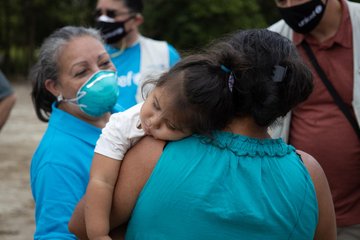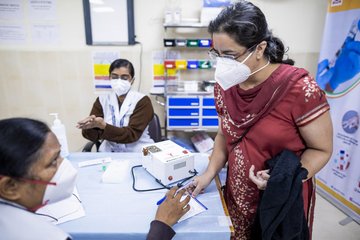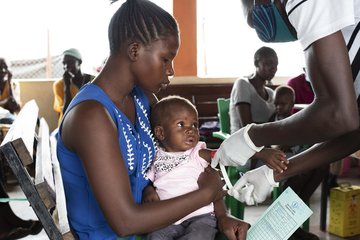Module 6
How to Participate
To participate in this training module, complete the following activities in the prescribed order:
- Complete the Pre-Test
- Read the training materials
- Complete the Post-Test

Learning Objective
By the end of this module, you should be able to: describe health workers' roles and responsibilities for COVID-19 vaccination; demonstrate effective and individualised communications about COVID-19 vaccination; explain communication strategies for three potential scenarios with community members; and explain the role of a vaccinator in crisis communication for adverse events following immunization (AEFI).
Health Workers Play an Important Role in COVID-19 Vaccination
The introduction of COVID-19 vaccination will not be successful without you. Health workers play four primary roles in COVID-19 vaccination:
- Early Recipients of the COVID-19 Vaccine Due to increased risk of exposure to the SARS-COV-2 virus while working. Health workers play a critical role in continuing the provision of essential health services during and after the pandemic.
- Vaccinators and health educators for COVID-19 vaccines Providing not only injections to community members but also key health messages.
- Advocates for COVID-19 vaccines Research has shown that community members trust the recommendations of health workers. By sharing your own experience of receiving it you can help increase the community's confidence and acceptance of COVID-19 vaccination.
- Representatives to the Community Health workers can be a bridge between the community and the health system, sharing information with the community and back to the health facility. This role is especially important during AEFIs that may influence community perceptions of the vaccine.
Building Community Confidence in the Vaccine
Good communication helps create and maintain respect and trust between health workers, families, and communities. You are the bridge between the health system and the community and your relationship with them is critical. Trust in that relationship can be easily lost if communication is inconsistent or misleading. You can better understand community members’ experiences and perspectives by asking questions and listening. If you respond to questions and concerns with empathy and with simple and practical information, it will help to increase their trust in you and ultimately reduce their refusal of the vaccine. It is also important to acknowledge the challenges, the community may face and show them respect according to their customs and culture.
Here are specific techniques that you can use during a vaccination session to build trust:
- Before the session begins try to set aside enough time to give personal attention.
- Welcome community members warmly and praise them for coming.
- For some, seeking out services can take great effort, time, and money. Encourage community members to express their feelings and ideas. Listen to them actively. This helps to demonstrate your interest and respect for them as individuals.
- If they express concerns, acknowledge those concerns with empathy even if the concerns do not seem important or relevant to you.
- When you provide health information during the session, it can be helpful to stop and ask questions to check the community members’ level of understanding
- At the end of the session, summarize and request a commitment to vaccinate.
Understanding and Responding to Vaccine Hesitancy
The WHO named vaccine hesitancy as one of the top 10 threats to global health in 2019.
Vaccine Demand Spectrum

This spectrum includes all levels of demand including community members who accept all vaccines, visualized in green, all the way to community members who refuse all vaccines, visualized in red. Vaccine hesitancy encompasses the middle section of the diagram. Here people may accept a vaccine but still feel some uncertainty about that decision. They may accept some vaccines, delay some and refuse some or they may refuse a vaccine but feel uncertainty around that decision.
Your communication strategy can be tailored based on a community members’ position on this spectrum of demand.
- For those who accept all vaccines, you can simply offer positive encouragement.
- For community members who display some hesitancy, it is important to have a discussion about their perceptions to better address concerns.
- For those who refuse vaccines, respond to their specific concerns and remember to remain respectful and do not argue. You can also point them to trusted community members and offer other sources of information.
Tailoring your Messages about the COVID-19 Vaccine
Below, you will find examples of community members and possible COVID-19 vaccine hesitancy messages with suggestions on appropriate response. These examples focus on how to respond to questions about side effects, social structures that affect decision making, and online rumours. Depending on your context, different questions may emerge. These responses can be tailored to the needs of your community.
Due to the limited global supply of COVID-19 vaccines, certain groups will be prioritized to receive COVID-19 vaccine first while others may have to wait until more vaccines are ready. Tailoring messages by risk group will help people understand why they are eligible and build trust and confidence in the vaccine.
Risk Groups and Key Messages:
Health Workers: The COVID-19 vaccine will help protect you from exposure while you are performing your job. By getting vaccinated, you can help reduce the risk of COVID-19 transmission to your patients, family, neighbours and community, and continue to provide essential health services.
Elderly or Older Person: COVID-19 has been shown to affect older people more adversely. The vaccine will help protect you from COVID-19 or from becoming severely ill if you are infected with the virus.
People with Chronic Conditions: COVID-19 has been shown to affect people with chronic conditions more adversely. The vaccine will help protect you from COVID-19 infection or from becoming severely ill if you are infected with the virus.
Essential Workers: As an essential worker who encounters other people in your day-to-day routine, the COVID-19 vaccine will help protect you from exposure while you are performing your job.
Vaccine Hesitancy Case Studies

Case Study No.1
A community member who has the potential to accept the COVID-19 vaccine.
Wan is a 38-year-old woman who is at the health facility for her infant’s well-baby care visit. Wan has diabetes and is overweight. She does not ask about the COVID-19 vaccine. You know that Wan always brings her baby for health visits and accepts routine vaccines. Wan has chronic conditions that put her at risk for developing severe COVID-19 infection.
Response
- Since Wan has shown a pattern of accepting vaccines for her child, you should use what we call a presumptive communication approach. With this approach you assume the community member will accept the COVID-19 vaccine.
- State that she will receive the vaccine today and share key messages about vaccine benefits, side effects, care for side effects and follow-up.
- If Wan consents and has no questions or concerns you should vaccinate.
- If she has concerns, listen and respond with empathy.
- You can use medical evidence or stories to convey information about the safety, effectiveness and need for the vaccine.

Case Study No.2
A community member who shows some hesitancy.
Yumi is a 25-year-old female, who arrives at the health facility for a family planning visit. She works as a nursing assistant in a high-risk area but has not received COVID-19 vaccine. When asked about the vaccine, Yumi says "I read it can cause health problems. Is that correct? I don't know if I should trust the vaccine".
Response
- Yumi works as a health worker in a high-risk area putting her at risk for exposure to the virus. Since Yumi is displaying some hesitation in receiving the vaccine, you should use what we call a participatory communication approach.
- With this approach, you engage in discussion with the community member to help identify and address misinformation and to help her better understand the importance of COVID-19 vaccine.
- Ask questions to discover the content and source of misinformation and help debunk information using key messages.
- You should ask her about her perceptions and preferences and listen and respond with empathy.
- Acknowledge risks and benefits of the vaccine and share medical evidence or stories to respond to concerns.
- If Yumi consents and has no questions or concerns, you should vaccinate.
- If she remains hesitant, be respectful and provide information for her to take home. Encourage her to consider vaccination in the future.

Case Study No.3
A community member who is not part of a priority group
Maria is a healthy 28-year-old female, who brings her infant for a wellness check. She says that while she is at the health facility, she would like to have a COVID-19 vaccine. Maria is a young healthy woman who is not a member of a priority group.
Response
- Recognize and appreciate Maria for her desire to keep herself and her family healthy.
- Explain that the current guidelines do not indicate that she should get the vaccine at this time.
- Encourage Maria to tell priority groups with whom she has contact to seek the vaccine.
- Advise Maria on COVID-19 preventive measures and provide information about when the vaccine might be available to non-priority groups.
Health worker’s role in crisis communication and AEFI
When an AEFI occurs it is often difficult for health workers to know what they should say, when they should say it and to whom they should speak. When responding to AEFI, keep these steps in mind:
- Offer reassurance to the community that the vaccine is given to protect them from COVID-19. Details that can be helpful include why the vaccine is given, its benefits and safety, common side effects and how to care for side effects.
- If you see that a person recently vaccinated has fallen seriously ill after vaccination, begin treatment immediately and refer to the appropriate health facility as needed. It is also helpful to gather basic information about the health issue, the timing of the health issue and when the vaccine was given. These details can then be shared with your supervisor.
- If you are approached by the media, do not speak to them. Refer media outlets to the AEFI focal point in your area. The focal point will have better information on what has happened and what needs to be done.
- As the bridge to the community, you should share with the community that an investigation is being carried out by the government. Let them know that as with all vaccines, it is normal to investigate any potential side effects and in the majority of cases the side effects turn out to not be due to the vaccine.
- While communicating, express empathy to the affected family and community.
- Never give incorrect or false information as this will erode trust. Tell them that you will share updated information at a specific date and time. Even if no new information is available at that time, maintain communication and provide a new date and time for the next update. This will help build and sustain trust between you and the community.
Key Summary Points on Communicating about COVID-19
- Health workers play important roles in COVID-19 vaccination. Whether you are a vaccinator, an early acceptor or advocate, you play an essential role in making the introduction of COVID-19 vaccine a success.
- Use empathy to put yourself in the community member's position. This will help you better understand and respond to their challenges and fears.
- Demonstrate caring behaviors and respect to community members. This will help foster trust and ultimately increase acceptance of COVID-19 vaccine.
- Tailor your communication strategy to risk group and position on the vaccine demand spectrum.
- Direct media to the AEFI focal point in your area. As the bridge between the health system and the community, communicate about AEFI early and honestly and explain when you will share updated information.
Additional Resources
- COVID-19 vaccine country readiness and delivery webpage
- Guidance on developing a national deployment and vaccination plan for COVID-19 vaccines
- Interpersonal communication for immunization: transforming immunization dialogue
- Demand for health services field guide: a human-centred approach
- The guide to tailoring immunization programmes
Average Rating: ☆ ☆ ☆ ☆ ☆ (0 reviews)




